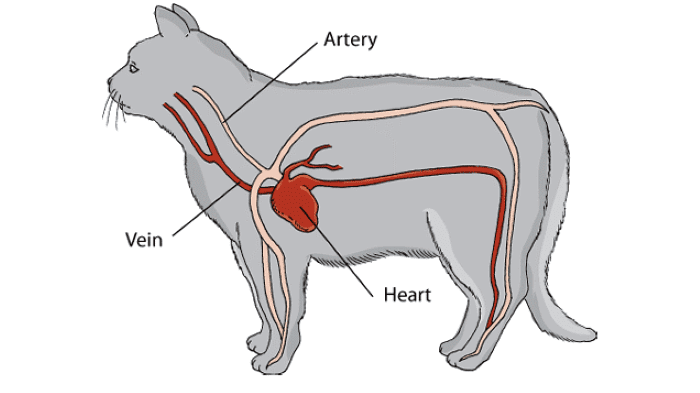The heart and the blood vessels form the cardiovascular system. The cat’s heart is a four-chambered pump, about the size of a walnut, made of special non-tiring cardiac muscle. It beats between 140 and 220 times each minute, depending on the level of activity, and its resting heartbeat of 140–180 beats per minute is about double that of a resting human.
The heart pumps blood around the body in two separate circuits. The pulmonary circuit takes stale, or deoxygenated, blood to the lungs to pick up oxygen. This freshly oxygenated blood then returns to the heart to be pumped around the body to all its organs and tissues in the larger circuit. Arteries have muscular walls that expand and contract as bright-red oxygenated blood surges through them with each heartbeat.
This creates a pulse that can be felt at various points of the cat’s body. Darker deoxygenated blood returns to the heart in thin-walled veins, which contain valves to maintain blood flow in one direction only.
A network of microscopic blood vessels called capillaries lies between the arteries and veins. Here, oxygen and other molecules, such as glucose, pass from the blood into surrounding cells and tissues. Wastes, such as carbon dioxide, pass in the opposite direction.
The brain makes up only 0.9 percent of a cat’s weight, but it receives up to 20 percent of blood flow. Muscles at rest receive 40 percent of blood flow, but this amount can rapidly increase to up to 90 percent during short bursts of exercise.
An averaged-sized cat of 11lb (5kg) has about 11fl oz (330ml) of blood in its body. By volume, blood is about 54 percent plasma, a watery liquid that carries food molecules such as glucose, salts, wastes, hormones, and other chemicals around the body.
Biconcave, disk-shaped red blood cells, which carry oxygen picked up from the lungs, account for another 46 percent of volume. The remaining 1 percent contains white blood cells, which fight infection, and cell fragments called platelets, which help blood clot at sites of injury.


